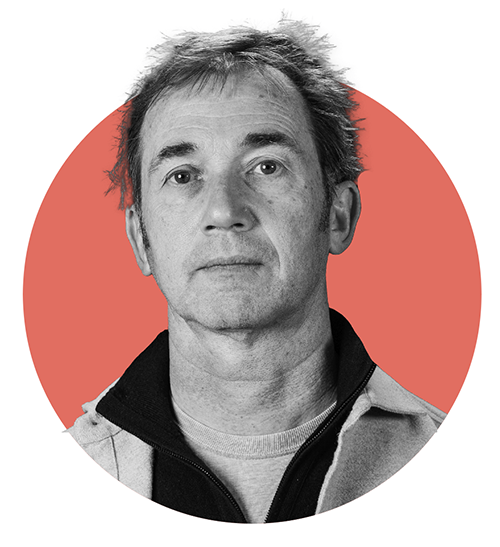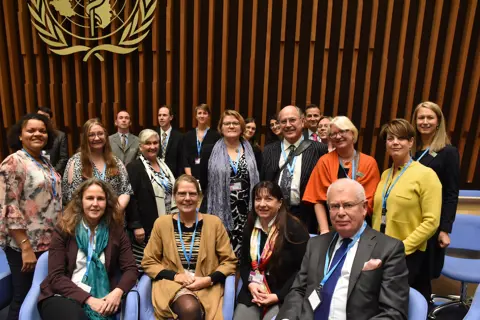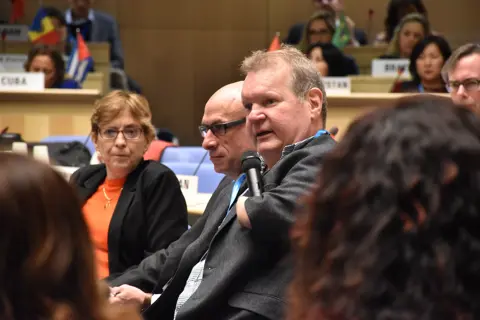
THE JUBILEE EVENT, marking both the 50th anniversary of the WHO programme and the 41st national centres’ meeting, was hosted by WHO and Swissmedic, at two venues in Geneva, Switzerland, in 2018. This celebration of half a century of global monitoring of medicines began at WHO headquarters with a series of special presentations from academics, students, and patient representatives in the spectacular Executive Board Room.
The opening session included a personal greeting from Dr. Mariângela Batista Galvão Simão, Assistant Director-General for Drug Access, Vaccines and Pharmaceuticals at WHO, and the screening of a short documentary about the history of the programme – featuring WHO’s Director-General, Dr Tedros Adhanom Ghebreyesus. In the film, Dr Ghebreyesus spoke of how, despite the best of intentions, any drug can have unintended consequences. This understanding, he explained, informed WHO’s decision five decades ago to create a global mechanism of pharmacovigilance.
Later in the agenda, an inspirational series of programme member success stories from each continent highlighted some of the significant strides made in recent years. In the session, representatives from Chile, Iraq, Montenegro, and Nigeria recounted their path to improvement – four different perspectives, but all sharing a clear, deep concern to make patients safer.
Not all founding programme members were present in Geneva, (indeed, Czechoslovakia and Federal Republic of Germany no longer exist in their 1968 form). But many recently joined members of the programme were present, including Azerbaijan, Georgia, Paraguay, and Syria – all new since the Kampala gathering in 2017. In all, more than 80 countries were represented – the most ever.
Outside the main hall, many countries displayed posters giving a snapshot of their pharmacovigilance system, illustrating the wide diversity of approaches within the one programme. In the refreshment area, a running slideshow of past attendees – dating all the way back to the late 1970s – was an effective reminder of the many individuals who have contributed to the development of the programme.
RECENT YEARS have seen an extension of the scope of pharmacovigilance. Newer areas of interest include effects directly related to the active ingredients and excipients; the results of medication errors, misuse, substandard and falsified drugs; and other problems that can occur along the supply chain. These issues are particularly critical in settings where the regulatory systems and general healthcare infrastructure is weak. In the future, existing reporting channels could even be used to discover signs of developing antimicrobial resistance.
In a keynote session entitled ‘Safer medicines – safer use of medicines – safer patients’, UMC director, Dr Marie Lindquist discussed how pharmacovigilance has evolved to be more patient-focused.
“In the early days, what we did was called drug safety, drug surveillance, and drug monitoring,” she said, explaining that the core question has now shifted from Did the drug cause the adverse reaction? to What happens to the person who takes a medicine?
“That’s an important change – the realisation that we need to look at all the complex interrelationships between people, their diseases and their therapy and to try to find out who might benefit from a particular treatment and who might not,” said Dr Lindquist. In practice, this means including patients in the decision-making process.
The importance of a patient-focused approach was also a theme of the panel discussion, ‘Pharmacovigilance success stories: the everyday miracle-makers’. In that session, Dr. Simão stressed the importance of ensuring patients all over the world have access to safe and effective medicine.
The president of the Swedish Thalidomide Society, Björn Håkansson, whose life has been shaped by one of the most infamous drug safety failures, concluded with a reminder of the programme’s significance.
“Safety of drugs is one of the most important things,” said Håkansson. “The job you’ve done is marvellous – keep it up.”

Over the following three days, Swissmedic hosted the technical meeting in offsite conference facilities. The packed technical agenda followed a familiar format: plenary sessions, tutorials, and working groups, with ‘Problems of current interest’ presentations – now renamed ‘Signals of current interest’ – rounding off the day.
Among the highlights was an examination of work on how to prevent known ADRs. The discussions ranged across the need to improve the basic labelling of products to the further development of reporting and analysis systems for substandard and falsified products – where work to set up an international database is slowly gathering momentum – to mass deployment programmes of collecting and sharing data for analysis.
WHO set out its plans for helping to improve the effectiveness of pharmacovigilance units with fewer resources. While the balance of the global database, VigiBase, is shifting – with increased submissions from China, India, and other centres, and African states are looking at new ways of focusing their drug safety activities – many of the centres in low-resource settings have weak systems in need of strengthening.

UMC actively contributed to the meeting across many fronts. One key advantage of the annual meeting is the one-to-one discussions with national centre staff, to hear about their experiences with UMC’s services and tools. UMC staff also demonstrated tools and presented tutorials on VigiFlow and signals, which are invaluable for understanding the practical application of these resources.
Swissmedic has supported WHO activities for many decades, as well as working with the International Conference of Drug Regulatory Authorities (ICDRA). Their staff, along with those of WHO’s Safety and Vigilance team did a wonderful job in organising this large, complex meeting, including a pleasant evening of food and wine in the hills outside Geneva. For the 50th anniversary of the programme, this event was a strong reminder of just how much personal connections, international dialogue, and individual voices can contribute to a global safety culture.




